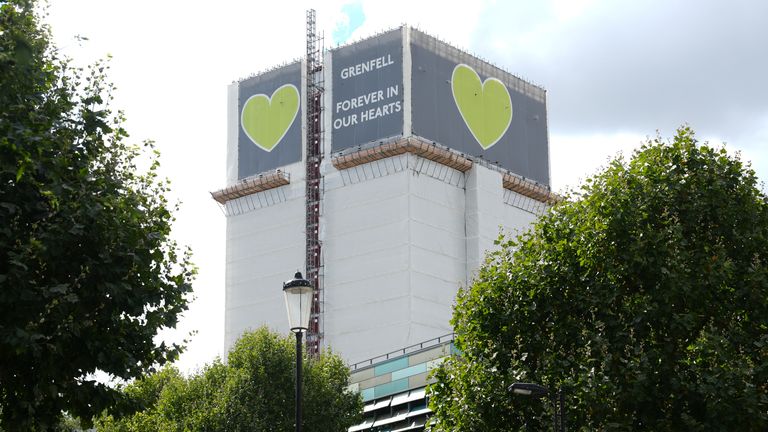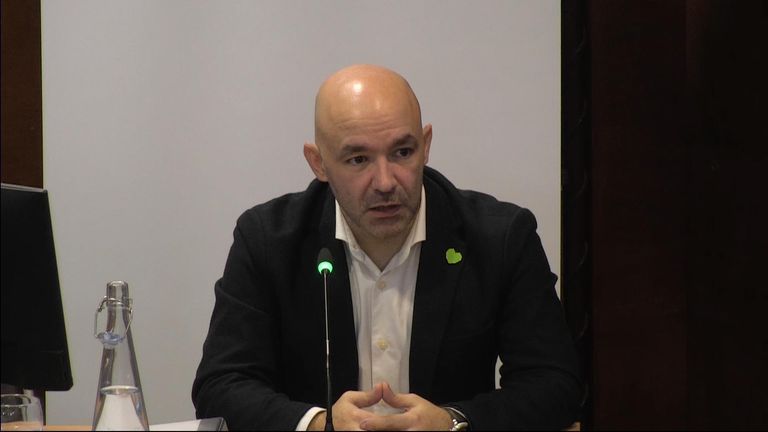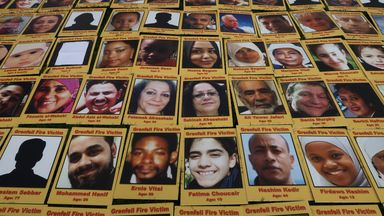Today, the years-long Grenfell Inquiry releases its final report into the fire that cost 72 lives.
What started as a small kitchen fire in the 24-storey Grenfell Tower, which contained 129 flats and stands at just over 200ft, ended up being the deadliest domestic blaze since the Second World War.
The report into phase one, published in October 2019, concluded the North Kensington property's cladding did not comply with building regulations and was the "principal" reason for the rapid and "profoundly shocking" spread of the blaze.
It also heavily criticised the London Fire Brigade (LFB) for "serious shortcomings" and "systemic" failures in its handling of the fire, specifically due to its controversial "stay put" strategy which meant residents were told to stay in their flats by firefighters and 999 operators for nearly two hours after the fire broke out.


The report published today relates to phase two, which looked into the critical circumstances and decisions leading up to the disaster - and it will name and shame those deemed responsible for devastation.
This is a minute-by-minute breakdown of exactly how the tragedy happened in the early hours of 14 June 2017, based on the statements of emergency workers and survivors.
12.54am: Behailu Kebede, 45 at the time, lives on the fourth floor in flat 16. He is asleep when his smoke alarm goes off and wakes to find white smoke billowing from behind his fridge-freezer. He dials 999 to report the fire.
12.59am: The first firefighters arrive on the scene. They are led by LFB watch manager Michael Dowden, a firefighter of around 13 years, who sees an "orange glow" coming from the window of flat 16.
1.06am: Mr Dowden notes the fire has "breached the window of flat 16". He later tells the inquiry this isn't uncommon in high-rise fires and therefore isn't too concerned.
1.09am: The fire in flat 16 breaks out into the exterior cladding of the building and starts to climb the east facade rapidly.
1.14am: Firefighters enter the kitchen of flat 16 for the first time.
1.16am: Mr Dowden becomes "uncomfortable" about the way the fire is burning, later saying he couldn't understand why it wasn't being suppressed as a breathing apparatus team was inside.
1.19am: Mr Dowden notices the cladding is alight. He would later tell the inquiry he felt "out of my comfort zone" and "helpless" as the fire took hold.

1.21am: Dr Naomi-Yuan Li, who is in flat 195 on the 22nd floor with her cousin, Lydia, calls 999 after smelling something "like burning plastic" while lying in bed using her phone.
1.25am: 56-year-old Dennis Murphy, who died during the fire, makes the first 999 to report smoke coming into a flat. He is in number 111, on the 14th floor.
His son Peter told the inquiry he also called his family to tell them he was trapped and struggling to breathe.
1.26am: Met Police declares a major incident. Residents are still being told to stay in their flats.
The "stay put" strategy is standard guidance for high-rise blocks and assumes that a fire will be contained in one room or floor, allowing firefighters to tackle flames while residents remain in their homes.
1.27am: The fire reaches the roof and starts to spread horizontally. Fire chiefs believe only the cladding from the outside is burning but that it is still controllable internally.
1.29am: Mr Dowden increases the number of pumps being used to 20 - having escalated from four, to six, to eight, to 10 and to 15 between 1.13am and 1.28am. He says he is becoming "increasingly concerned".
The amount of pumps is used by firefighters to measure the severity of a fire.
1.30am: Miriem Elgwahry, 27, is the first person to call 999 reporting that the fire is penetrating a flat. She was with her mum Eslah Elgwahry in flat 196 on the 22nd floor.
Miriem's brother Ahmed Elgwahry said he was on the phone to them later that night and they were telling him they couldn't breathe. Miriem and Eslah died later that night.
1.31am: After firefighter David Baddilo tells Mr Dowden they need more resources, the watch manager increases the pumps to 25.
By this time 110 out of 297 occupants have escaped, as the fire starts to spread to the north elevation of the tower.
1.42am: The London Ambulance Service declares a "significant incident".
A report by fire protection expert Dr Barbara Lane states residents should have been told to evacuate by around this time at the latest, but the "stay put" policy remains in place.
1.45am: The first police helicopter arrives at the scene.
1.50am: Mr Dowden hands over incident command to station manager Andrew Walton, who had been listening to the incident on the radio while on a standby shift. By this time 168 of 297 occupants have escaped, though firefighters don't know the numbers at this stage.
1.58am: Mr Walton is still trying to inform firefighters that he is in charge of the incident when he sees DAC Andrew O'Loughlin, who is two ranks above him, "making big steps" towards him.
Mr O'Loughlin, who has been a firefighter since 1989, had heard 25 pumps mentioned on his radio and knew it was an "exceptional" situation, and that "something very serious was going on". He is surprised there aren't more high-ranking officers at the scene already.
He asks Mr Dowden how many people were still in the building, but he doesn't have a number. He says many people have already come out from the lower floors, and Mr O'Loughlin estimates there are between 100-200 people still in there.
Read more:
Grenfell victims: Those who lost their lives in the fire
Seven years on from Grenfell, fire safety is still being ignored
"We didn't know the condition, age, ambulatory or health issues of any of these people and so I knew that getting them down a smoke logged staircase was going to be a challenge," he would later say, explaining why he felt the "stay put" advice would be best for some of the people in the building.
2am: Flames travel across the north and east elevations of the tower, and start to spread around the top of the building and diagonally across the face of the building, affecting flats in the southeast and northwest corners.
2.04am: Group manager Richard Welch declares himself incident commander and increases the number of pumps to 40, not knowing that Mr O'Loughlin has already assumed command.
2.06am: Mr Welch declares a major incident on behalf of the LFB.
2.11am: Mr Welch realises Mr O'Loughlin is on site, apologises for taking control and fills him in on what he has done. Mr O'Loughlin thanks him and says he is happy with the actions he took.
2.15am: Senior operations manager Joanne Smith, who has 23 years' experience, arrives at LFB's control room and receives a briefing.
2.20am: Flames start to spread to south elevation. Between now and 2.50am, the control room receives 35 emergency calls from or on behalf of trapped Grenfell residents.
One was from Marcio Gomes in flat 183 on floor 21, who was trapped with his wife, who was seven months pregnant, and his two daughters. Mr Gomes, his wife and daughters survived the blaze, but his son Logan was stillborn in hospital as a result of the smoke.

2.23am: A Met Police operator calls LFB's control room to tell them a caller is trapped on the 23rd floor and their phone has cut out.
One of the LFB's control room officers responds: "I think they're trapped everywhere."
2.26am: The London Ambulance Service (LAS) declares a major incident.
2.35am - 'stay put' advice is revoked
Ms Smith has been listening in to two long-running emergency calls, one of which is with the El-Wahabi family in flat 182 on floor 21.
The El-Wahabi family consisted of Abdul Aziz, 52, and his wife Fouzia, 42, and their three children - 21-year-old Yasin, 16-year-old Nur Huda and eight-year-old Mehdi. They all died on the 21st floor.

Ms Smith says listening to these calls is making it clear the situation is getting worse in terms of smoke and heat, and she becomes "increasingly uncomfortable with the 'stay put' policy".
The LFB control room decides to revoke the "stay put" advice and tells all occupants calling 999 to leave the tower at all costs and that it is a matter of life and death.
Mr O'Loughlin, still in charge of the scene at Grenfell, later tells the inquiry he wasn't informed of this change for some time and that he was "confused" by it once he was.
2.44am: LFB assistant commissioner (AC) Andy Roe takes over incident command from Mr O'Loughlin. He later tells the inquiry Mr O'Loughlin had not revoked the "stay put" advice at that time.
Mr Roe, who joined the LFB as a firefighter in 2002 and had been made AC in January 2017, says he knew as soon as he arrived on the scene that there had been a "complete building system failure" to contain the blaze.
He could see the whole tower from the third floor upwards was alight.
2.47am: Mr Roe officially revokes the "stay put" advice.
He says in his testimony he doesn't recall being told that the control room had already stopped giving the "stay put" advice, and that he made the decision solely because he could see the fire had spread in all directions, resulting in a total failure of compartmentation - a safety feature designed to keep a fire in the region of origin.
Inquiry chairman Sir Martin Moore-Bick later said more lives could have been saved had a "stay put" policy been abandoned sooner - but Mr Roe was individually praised for making the call.
2.50am: The fire spreads horizontally across the south elevation at the top of the building.
3am: The fire starts to spread across the west elevation of the tower, from north to south.
3.20am: Mr Roe chairs the first Tactical Co-ordination Group (TCG) meeting, attended by representatives of the Met Police, the LAS and the Royal Borough of Kensington and Chelsea.
At this stage, 100 people are believed to be trapped in the tower and it is understood three people have died.
4.02am: Fires on the south and west elevations start to converge at the top of the southern corner of the west face. Rescue efforts across the building continue for hours.
8.07am: Elpidio Bonifacio, a partially sighted retiree, becomes the last survivor to leave the tower when two firefighters rescue him from his flat on the 11th floor.
Mr Bonifacio, whose wife of 42 years was at work, later tells the inquiry he had "lost all hope" and was "ready to die" before the firefighters came and supported him down the staircase.
The aftermath
It wasn't until November 2017 that the identities of all 72 deaths were confirmed by authorities. Among them were 53 adults, 18 children and a stillborn baby who died on the day of the blaze. One of the people who lost their lives was 10-weeks pregnant.
The first report from the Grenfell Inquiry found the LFB's preparation for a tower block blaze such as Grenfell was "gravely inadequate" and its lack of an evacuation plan was a "major omission".
Inquiry chair Sir Martin Moore-Bick did, however, praise the "extraordinary courage and selfless devotion to duty" of firefighters and said "those in the control room and those deployed on the incident ground responded with great courage and dedication in the most harrowing of circumstances".
Sky News will have full coverage of the Grenfell report when it is published at 11am - watch a special programme on the disaster on Sky News at 8pm
Disclaimer: The copyright of this article belongs to the original author. Reposting this article is solely for the purpose of information dissemination and does not constitute any investment advice. If there is any infringement, please contact us immediately. We will make corrections or deletions as necessary. Thank you.



